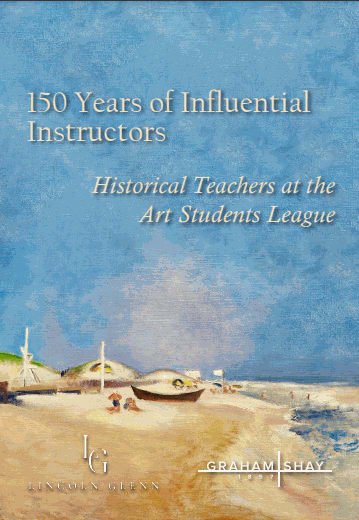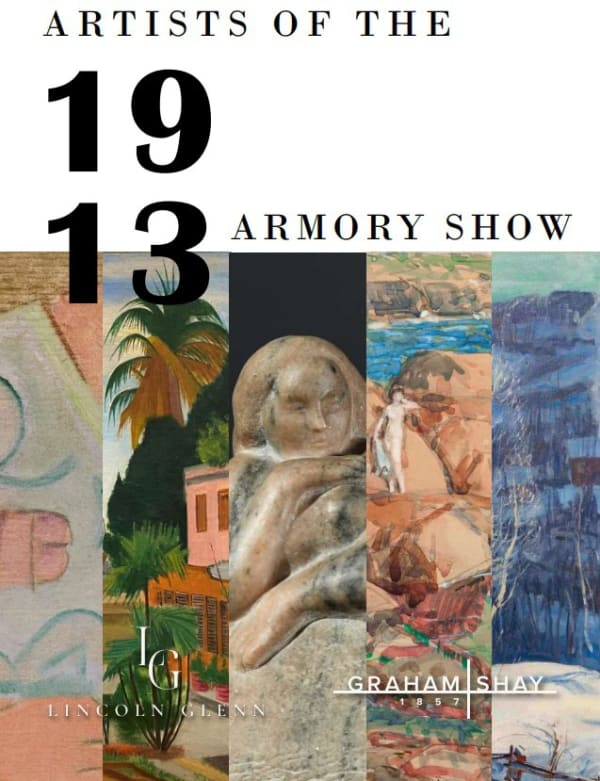After his arrival from Columbus, Ohio in 1904, Bellows lived at the West Side YMCA. It was there that he met Eugene Speicher, another aspiring young artist who was to become his lifelong friend. Always interested in the anatomy of the human body, Bellows often satirized the various types who, while leading a sedentary life, feel compelled to devote a portion of their daily routine to physical self-improvement.
Throughout his brief but illustrious career, George Wesley Bellows created striking scenes that documented ordinary American life in all its beauty and banality. Considered an American Realist, the artist eschewed embellishment, finding inspiration in the gritty boroughs of New York City, the rocky coastline of Maine, and, later, in his friends and family. Bellows garnered early recognition for his arresting portrayals of illegal prizefighting, dramatic works executed in dark tonal palettes that underscore the brutality of the violent sport.
Bellows’ elderly Methodist parents hoped their son might pursue the ministry, a calling the extroverted athlete never received. The Columbus native competed on the baseball team at Ohio State University and also served as an illustrator for the college yearbook. In the fall of 1904—just months shy of his expected graduation—Bellows defied his father’s wishes and boarded a train to New York City in hopes of becoming a magazine illustrator like his idols Howard Chandler Christy and Charles Dana Gibson. Before leaving, he reportedly turned down an offer to play professional baseball with the Cincinnati Reds.
Upon his arrival, Bellows enrolled in courses at the New York Art School, also called the “Chase School” after its renowned founder and the pioneer of American Impressionism, William Merritt Chase. He received instruction from Chase, as well as Robert Henri, a fellow Midwesterner who first encouraged Bellows to take to the streets of Manhattan in search of subject matter. Henri was the leader of an informal association of artists known as “The Eight.” These men spurned the confines of the European academic tradition and chose instead to record working-class street life, in all its color and complexity, with unvarnished realism. The group—which, along with Bellows and Henri, included William Glackens, Ernest Lawson, George Luks, Maurice Prendergast, Everett Shinn, and John Sloan—was later identified as “Ashcan School,” a designation derived from Bellows’s grim drawing Disappointments of the Ash Can (1915), in which three men examine the worm-ridden contents of a filthy waste receptacle.
Bellows’s vigorously executed oil paintings met with early critical and commercial success. He was elected an associate of the National Academy of Design in 1909, and full membership accrued in 1913—notable achievements for such a young artist. Along with his teaching duties at the Art Students League, Bellows produced over 170 lithographic images and was a prolific illustrator. He contributed to many of the popular periodicals of the day, including Vanity Fair, Harper’s Weekly, and Metropolitan Magazine, as well as the socialist publication The Masses. Indeed, many of Bellows’s drawing and prints reveal an acute interest in social and political issues, such as a series that gruesomely detailed German atrocities during World War I. Intrigued by the modernist art theories emanating from Europe, Bellows was an organizer and exhibitor at the landmark Armory Show of 1913. When he succumbed to peritonitis—triggered by a ruptured appendix—in January of 1925, the forty-two-year-old was considered one of the most popular painters in America.
In 1908, Bellows accepted a six-week summer teaching position at the University of Virginia in Charlottesville, during which time he painted Footpath Virginia. Markedly different in composition and style from his New York scenes, the loosely-painted Footpath depicts two women taking a leisurely stroll on a summer day. One of the vignette’s subjects has been identified as Miss Marie Ellis Bowles of Staunton, Virginia, a student to whom Bellows gave the painting. Footpath is one of three works that Bellows completed during his Southern stay.





